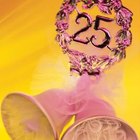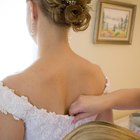
When you have two sisters or two best friends, choosing a maid of honor can become a source of stress and tension. Luckily, modern etiquette and wedding experts agree that stringent wedding traditions are a thing of the past. On your special day, you're welcome to make your own rules to address special situations.
Choosing a Maid of Honor
Even etiquette expert Peggy Post agrees that you don't have to stick to just one maid of honor, but it's also important to remember that you don't have to distribute honors simply to avoid hurting feelings. Just because you have more than one sister doesn't mean they all have earned the MOH title and duties. If you are closer to one sister, perhaps due to age or geographic location, you can choose her. While you should do what makes you happy, consider all aspects of your happiness -- will choosing one sister over another create unneeded stress in your family or between you and your siblings? No matter your choice, be clear with your sisters and friends about their potential role when asking them to be a part of your bridal party to ensure there is no confusion.
Choosing Two Maids of Honor
There are many ways that you can accommodate two Maids of Honor. If one sister is married and the other is not, you can have a Maid of Honor and a Matron of Honor. Otherwise, you can have two Maids of Honor or a Maid of Honor and an Honor Attendant. Just remember to be clear about the distribution of duties. Maids of Honor are often expected to help choose the wedding dress, plan a bridal shower and Bachelorette Party and assist with other planning activities. On the wedding day, the Maid of Honor traditionally assists the bride with any thing she might need, from assistance with her dress, to holding flowers, to fielding questions from guests.
The Traditional Bridal Party
The traditional bridal party includes a maid (unmarried) or matron (married) of honor and bridesmaids, usually limited to 12, with fewer for smaller weddings. Brides can also help to choose the flower girl and ringer bearer, a young girl and boy who are often relatives of the bride or groom. Other members of the wedding party include the best man, groomsmen and ushers. The wedding couple's parents are sometimes also considered members of the wedding party.
The Contempoary Bridal Party
In modern times, the bridal party can be adjusted to best fit your needs. Women who have many young relatives, such as nieces and nephews, might have bridesmaids and junior bridesmaids. Contemporary weddings also have mixed-gender bridal parties, though a male in a bridal party is usually called an "attendant" not a "bridesmaid." With so many "mix-and-match" options, it's okay to have one maid of honor, two maids of honor or a party full of bridesmaids with no maid of honor at all! You can include even more friends and family in the festivities by assigning reader positions for Bible passages or poems presented at the ceremony.
Related Articles

Who Could Walk Me Down the Aisle Since ...

Mother of the Bride Dress Etiquette

Do the Groom's Parents or Bride's ...

Morning Wedding Etiquette

Bachelorette Party Ideas for the Mormon ...

Types of Wedding Dresses

What Are the Duties of the Groom's Aunt ...

The Customs of Filipino Wedding ...
Who Traditionally Pays for a Baby Shower

What Type of Bouquet Is Appropriate for ...

Bridal Bouquet Etiquette: Who Pays?

Bridesmaid & Groomsmen Traditional ...
How Much to Give for a Wedding Gift

How to Renew Vows After a Separation

What Can Small Boys Do to Be a Part of ...
Do You Bring a Gift to an Engagement ...

What Does the Corsage Symbolize?

Quinceanera and Chambelan Outfit Ideas

The Meaning of a Flower Girl in a ...

Duties of Honorary Bridesmaids
References
Writer Bio
Paige Johansen has been writing professionally since 2003. She holds a B.A. in psychology and English from Cornell University and an M.F.A. in fiction writing from The University of Virginia. Between degrees, she worked in the fashion industry for two years.
Photo Credits
Jupiterimages/Polka Dot/Getty Images